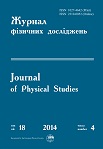Journal of Physical Studies 27(3), Article 3701 [12 pages] (2023)
DOI: https://doi.org/10.30970/jps.27.3701
CLOSED CLUSTERS APPROACH TO GRAPHENE
Ilja I. Taljanskij
Department for Theoretical Physics, Ivan Franko National University of Lviv;
current address†: Rudolf-Breitscheid-Strasse 39, 23968 Wismar, Germany
†We publish this paper to honor the 95th anniversary of the late Professor Illya Talyansky (1928–2018).
The original version appeared in 2015 as a preprint: https://arxiv.org/abs/1508.05385 and has never been published till now.
A brief biographical note about Prof. Talyansky is given at the end of the paper.
We appreciate the feedback from the family (Raisa Kociurzynski and Olga Talianska) regarding some biographical details.
|
 |
The Closed Cluster method (CC method) is applied to find solutions for various calculation problems of the energy band structure of graphene.
The essence of the CC method consists in the addition of closing bonds between edge atoms to the usual cluster method in order to eliminate the
“dangling” bonds on the edges of the cluster. We study the cases of an “infinite” layer of graphene as well as nanoribbons, nanotubes and bilayer
graphene. Results for these cases are in agreement with what was obtained using other methods (tight binding approximation and others).
Using the CC method, we also study the problem of point defects in graphene and obtain the distortion of the energy spectrum.
The energy spectrum of the layer C1−xSix (0 ≤ x ≤ 1) is found as well as the dependence of the energy gap
on the concentration of silicon. We show that the energy band structure of C1−xSix looks like a tunnel transition.
Wave functions of graphene in the symmetry points of Brillouin zone are also obtained.
Key words: graphene, energy band structure, point defects, nanostructures.
Full text
References
- K. Wakabayashi, in Graphene Nanoelectronics: Metrology, Synthesis, Properties and Applications, edited by Hassan Raza (Springer, Berlin–Heidelberg, 2012), p. 277;
Crossref
- I. I. Tal'yanskij, Fiz. Elektron. 28, 8 (1984).
- M. Lannoo, J. Bourgoin, Point Defects in Semiconductors. I. Theoretical Aspects (Springer, Berlin–Heidelberg, 1981);
Crossref
- A. K. Geim, K. S. Novoselov, Nat. Mat. 6, 183 (2007);
Crossref
- P. R. Wallace, Phys. Rev. 71, 622 (1947);
Crossref
- N. Trinajstić, Chemical Graph Theory (CRC Press, Boca Raton, Florida, 1983), Vol. I.
- E. Heilbronner, H. Bock. The HMO Model and its Application (Wiley & Sons Verlag Chemie, Weinheim, 1976).
- A. H. Castro Neto, F. Guinea, N. M. R. Peres, K. S. Novoselov, A. K. Geim, Rev. Mod. Phys. 81, 109 (2009);
Crossref
- T. Seyller, Phys. J. 9(8/9), 53 (2010);
https://www.pro-physik.de/restricted-files/100121
- T. Au-Chin, K. Yuan-Sun, Y. Guo-Sen, T. Shu-San, Graph Theoretical Molecular Orbitals (Science Press, Beijing, China, 1986).
- I. O. Vakarchuk, Quantum Mechanics, 3rd edition (Lviv University Press, Lviv, 2007).
- K. Wakabayashi, K. Sasaki, T. Nakanishi, T. Enoki, Sci. Technol. Adv. Mater. 11, 054504 (2010);
Crossref
- M. Fujita, K. Wakabayashi, K. Nakada, K. Kusakabe, J. Phys. Soc. Jap. 65, 1920 (1996);
Crossref
- K. Nakada, M. Fujita, G. Dresselhaus, M. Dresselhaus, Phys. Rev. B 54, 17954 (1996);
Crossref
- L. Brey, H. A. Fertig, Phys. Rev. B 73, 235411 (2006);
Crossref
- I. I. Tal'yanskij, B. L. Yudanin, Fiz. Tv. Tela 19, 3040 (1977).
- B. Trauzettel, Phys. J. 6(7), 39 (2007);
https://www.pro-physik.de/restricted-files/110496
- I. I. Talyansky, J. Phys. Stud 1, 106 (1996);
Crossref
- I. I. Talyansky, A. T. Maksymov, J. Phys. Stud. 1, 564 (1997);
Crossref
